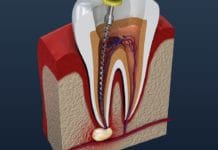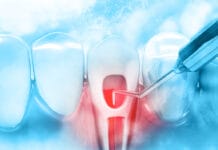Dental hygiene is a profession of life-long learning with new studies and discoveries constantly providing a plethora of information and products to help patients navigate various oral conditions. The steady stream of research and treatment options can be helpful, but keeping up with the safety and efficacy of these products can be hard for dental hygienists and patients alike. Increased antibiotic resistance and the laundry list of side effects accompanying many current treatment modalities have promoted a movement to simplify what we put into our bodies. Derived from natural plant sources in their purest forms, essential oils have ancient roots in medicine and have found new life in recent years due to their wide range of health benefits.
Melaleuca alternifolia, more commonly known as tea tree oil (TTO), is a stand-out essential oil with broad-spectrum antimicrobial, antifungal, antiviral, antioxidant, and anti-inflammatory properties.2,3 Native only to Australia, true tea tree oil is produced as a distillate of leaves from the melaleuca alternifolia shrub called a paperbark tree.5 Its medicinal properties were first discovered in the 1920s by Dr. Penfold who found it to be twelve times more potent than the current antiseptic of the time.1
TTO is made up of over a hundred compounds, but two specific compounds give this essential oil its punch. Terpinen-4-ol promotes healing and has a proven antimicrobial effect against fungal biofilms. Second, cineole compounds add disinfectant properties, but may also be caustic to the skin in higher concentrations. Good quality tea tree oil will have a high percentage of terpinen-4-ol and low cineole. The composition of oil marketed as tea tree oil is regulated by an international standard set by Australia of at least 30% terpinen-4-ol with 40-60% preferred for medicinal applications. In turn, less than 10% cineole should be present, with closer to 2.5% preferred for safe use on skin. Tea tree oil may be applied to the skin, or taken orally, but should not be swallowed.1,2
International standards do not stipulate a source for tea tree oil and the USDA does not regulate essential oils. It is important to research the quality and source when purchasing essential oils for dental applications. Tea tree oil should be stored in dark, cool, dry conditions in a container with little air.1
Melaleuca or tea tree oil has been used to treat Staphylococcus aureus (MRSA), and influenza viruses. In dentistry, it has shown the ability to inhibit adhesion of periodontopathic and cariogenic bacteria like P.gingivalis and S.mutans. Tea tree oil is helpful in the treatment of aphthous ulcers, herpes simplex virus, dental pain, periodontitis, and refractory oral candida infections.2,4,5 TTO can be found in toothpaste, mouth rinses, toothpicks, coated floss, and gels.
Research has been done to evaluate if tea tree oil is able to reduce plaque formation and oral bacteria numbers. In one study, the results showed a 0.2% tea tree oil mouth rinse used once daily for seven days significantly reduced the number of S.mutans and the total number of oral bacteria. This effect was consistent up to two weeks after use of the mouth rinse was stopped. However, in comparison to a placebo, there was no difference in plaque accumulation. A 2.5% tea tree oil solution was also studied in orthodontic patients, and did reduce gingival index and papillary bleeding scores, but seemed to confirm other studies in which it was determined that tea tree oil might reduce oral bacteria, but not necessarily plaque formation.1
Mouth rinses containing melaleuca have been shown to treat even azole-resistant oral candida infections effectively. In a study of refractory oral candida in patients living with AIDS, a 15mL melaleuca oral solution was swished for 30-60 seconds, four times daily, for two weeks. Participants were not permitted to eat or drink for thirty minutes following the rinse. Some experienced mild to moderate burning that seemed to decrease over time as the candida infection improved. At a six-month follow-up, 67% of participants oral candida infections had significantly improved, or been cured, without recurrence.2,4
Tea tree oil has also been proven to be a great adjunct in the treatment of periodontal disease. The goal of non-surgical periodontal treatment is to halt the disease and resolve inflammation, but many studies have shown that mechanical debridement alone cannot eliminate causative bacteria.
A 2013 study used gingival crevicular fluid samples to monitor the presence of pentraxin-3 (PTX3), which is an inflammatory molecule, as a marker for periodontitis.3 Baseline samples, as well as those taken at one, three, and six-month follow-ups, were compared. Two groups of patients with moderate to severe periodontitis were treated with scaling and root planing; the second group also received 5% methylcellulose tea tree gel sub-gingivally following SRP treatment. Sub-gingival delivery has been shown to provide a 100-fold higher therapeutic dose than systemic delivery. Results showed no change in plaque index (aligning with other research), but there was a significant improvement in CAL and PPD in group two as compared to group one. It was determined that the 5% tea tree oil gel did help reduce oral bacteria and inflammatory PTX3 molecules for a better treatment outcome than SRP alone.3
The Dentsply Sirona Cavitron directions for use does include essential oils mouth rinse in its list of compatible medicaments, although Dentsply Sirona responded that tea tree oil has not been specifically tested. Two drops of high-quality tea tree oil directly into the water reservoir and a thorough flush with clear water following use was recommended. This is a great mode of delivery and might encourage dental hygienists to recommend melaleuca or other essential oils in water flossers at home. However, one popular brand of water flosser on the market does not recommend any type of essential oil use to due to possible part degradation and development of performance issues. Always check with the manufacturer prior to using essential oils as an additive with any ultrasonic, sonic, or mechanical oral hygiene tools.
There are over 3000 essential oils, tea tree oil being one of the most widely researched. Essential oils present dental hygienists with outside the box options for patients looking for simpler, more natural ingredients with a comparable dental benefit to traditional products Due to the proven oral health benefits and availability of dental products containing tea tree oil, it is an easy choice for dental hygienists to incorporate into daily practice and recommendations.
SEE ALSO: Should Essential Oils Be Used in a Dental Setting?
DON’T MISS: Oil Pulling: Is It Effective?
References
- Carson, C. F., Hammer, K. A., & Riley, T. V. (2006). Melaleuca alternifolia (Tea Tree) oil: a review of antimicrobial and other medicinal properties. Clinical microbiology reviews, 19(1), 50-62.
- Dagli, N., Dagli, R., Mahmoud, R. S., & Baroudi, K. (2015). Essential oils, their therapeutic properties, and implication in dentistry: A review. Journal of International Society of Preventive & Community Dentistry, 5(5), 335-40.
- Elgendy, E. A., Ali, S. A., & Zineldeen, D. H. (2013). Effect of local application of tea tree (Melaleuca alternifolia) oil gel on long pentraxin level used as an adjunctive treatment of chronic periodontitis: A randomized controlled clinical study. Journal of Indian Society of Periodontology, 17(4), 444-8.
- Jandourek A, Vaishampayan JK, Vazquez JA. Efficacy of melaleuca oral solution for the treatment of fluconazole refractory oral candidiasis in AIDS patients. AIDS. 1998;12:1033–7.
- Ramage, G., Milligan, S., Lappin, D. F., Sherry, L., Sweeney, P., Williams, C., Bagg, J., … Culshaw, S. (2012). Antifungal, cytotoxic, and immunomodulatory properties of tea tree oil and its derivative components: potential role in management of oral candidiasis in cancer patients. Frontiers in microbiology, 3, 220. doi:10.3389/fmicb.2012.00220












